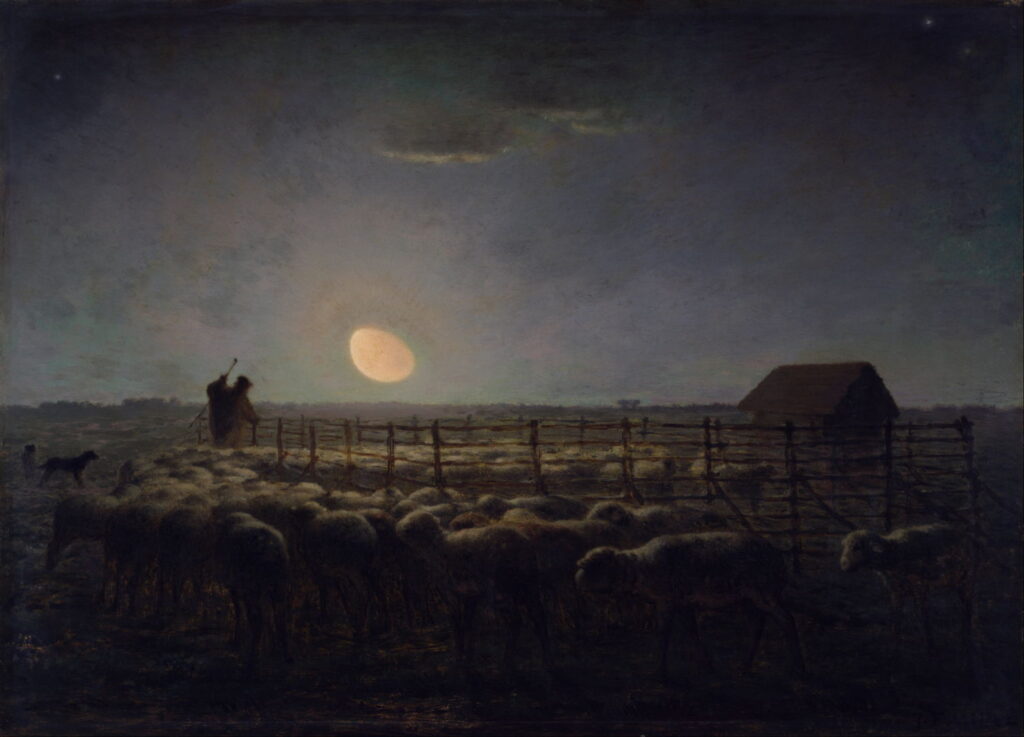The Real Country: 7 Meat, milk, fleece and dung

So far in this series, I have concentrated on the production of staple cereals such as wheat and rye. The fundamental aim of that arable farming is simply to multiply the number of grains of cereal, so that for each seed sown there are more harvested and delivered as food. Example figures given by Mark Overton for a typical English farm in the early sixteenth century suggest a gross wheat yield of 8-12 bushels per acre (forgive the antiquated units!), for a fixed cost in seed of 2.5 bushels per acre, giving net yields of 5.5-9.5 bushels per acre. By 1854, net yield of wheat had risen to 30 bushels per acre.
Early arable farmers realised that soil quality was key to the efficiency of this process. When seed is sown in soil of high fertility, then harvest yield will be higher. Thin soils were easiest to cultivate but also the quickest to lose their fertility, so farmers had to develop methods for increasing soil fertility to compensate. Among those discovered to be beneficial were:
‘resting’ the soil by leaving it fallow and uncultivated;
growing a nitrogen-fixing crop such as clover or legumes (peas or beans);
applying fertiliser such as dung.
The first two resulted in systems of crop rotation, a subject I’ll cover in the future. This article looks at one of the most popular methods for delivering fertiliser in the form of animal dung, using sheep, the best mobile source available in much of Europe at the time.
Sheep have other value as farm livestock, providing meat, milk and fleeces, but those were limited relative their value as fertilisers of the soil. During the day, sheep both graze and deposit dung and urine on the ground; at night they stop grazing, but continue to drop dung and urine. Daytime dung therefore fertilises their grazing pastures, while that of the night can be used to fertilise the soil used to grow cereals. The value of the latter was so great that many landowners controlled its rights, known as folding rights, to benefit their own land with sheep dung rather than the soil of their tenants.
Jean-François Millet (1814–1875), Shepherd Tending His Flock (c 1862), oil on canvas, dimensions not known, The Brooklyn Museum, New York, NY. Wikimedia Commons.
Jean-François Millet’s Shepherd Tending His Flock shows thin and scrawny sheep feeding on the stubble left after harvest, common practice in areas with lighter soils where sheep-corn farming became popular.
Anton Mauve (1838–1888), The Return of the Flock (1886-7), oil on canvas, 100.2 x 161.4 cm, Philadelphia Museum of Art, Philadelphia, PA. Wikimedia Commons.
Anton Mauve’s Return of the Flock (1886-7) shows a small flock of unshorn ewes with young lambs, in the late Spring or early summer, possibly on the move to or from folding.
Samuel Palmer (1805–1881), Evening (1834), engraved by Welby Sherman, mezzotint on paper, 14.9 x 17.8 cm, The Tate Gallery (Presented by Herbert Linnell 1924), London. © The Tate Gallery and Photographic Rights © Tate (2016), CC-BY-NC-ND 3.0 (Unported), http://www.tate.org.uk/art/artworks/palmer-evening-engraved-by-welby-sherman-n03869
This engraving by Welby Sherman from one of Samuel Palmer’s sketches in his Shoreham sketchbooks, Evening (1834), shows a small flock in a fold at night, where they’re fertilising the soil as the shepherd dozes behind them.
Jean-François Millet (1814–1875), The Sheepfold, Moonlight (1856-60), oil on panel, dimensions not known, Walters Art Museum, Baltimore, MD. Wikimedia Commons.
The most famous of Millet’s few nocturnes, The Sheepfold, Moonlight from 1856-60, shows a shepherd working his dogs to bring his flock into a fold or pen on the plain near Barbizon. He is doing this under a waning gibbous moon lighting the backs of the sheep.
Strangely, folding of sheep as a mobile source of dung as fertiliser was widely practised across England, but almost unknown in the Low Countries including the Netherlands. As a practice it could compromise the value of sheep for other purposes. Those grazing on rolling chalk downs in daytime might have to walk several miles each day to drop their dung overnight in arable fields in the valley, and return, so fattening less for slaughter.
Constant Troyon (1810–1865), On the Way to Market (1859), oil on canvas, 260.5 x 211 cm, Hermitage Museum, Saint Petersburg. Wikimedia Commons.
Sheep could also be driven longer distances to market, as shown in Constant Troyon’s On the Way to Market from 1859.
Heinrich Bürkel (1802–1869), Shepherds in the Roman Campagna (1837), oil on canvas, 48.3 x 67.7 cm, Bayerische Staatsgemäldesammlungen, Munich, Germany. Wikimedia Commons.
Heinrich Bürkel’s Shepherds in the Roman Campagna from 1837 has an almost documentary quality, in the rough and dusty peasants slumped on their horses and donkeys. In the foreground a couple of ewes are looking up at their lambs being carried in a pannier, and a dog is challenging a snake by the roadside.
In areas where domestic animals moved between highland pastures for the summer, and lowland grazing for the winter, including much of Spain, sheep could cover great distances each year in the transhumance.
Realising the value of their fleeces required annual shearing by hand.
Samuel Palmer (1805–1881), The Shearers (c 1833-5), oil and tempera on wood, 51.4 x 71.7 cm, Private collection. WikiArt.
The Shearers (c 1833-35) is the most ambitious of Samuel Palmer’s works from his period at Shoreham. This shows the seasonal work of a shearing gang, in a sophisticated composition drawing the gaze to the brilliant and more distant view beyond. The curious collection of tools to the right was the subject of preparatory sketches, and seems to have been carefully composed. However they have defied any symbolic interpretation, and may just ‘look right’.
Jean-François Millet (1814–1875), Sheep Shearing (c 1854), oil on panel, 16.2 × 11.3 cm, Private collection. Image by Caful111, via Wikimedia Commons.
Millet’s Sheep Shearing from about 1854 shows the highly skilled task of hand-shearing the fleece from a sheep. A man holds the animal still, resting over the end of a large barrel. A woman is using hand shears to cut the fleece from the sheep, as was universal before the introduction of machine shearing from 1888. Even with highly skilled hands, this is a difficult process, and it’s hard to remove the complete fleece. In some parts of the world, itinerant shearing teams would have performed this task, but for small flocks on poor farms it had to be carried out by those working the farm.
Fleeces generated the wool trade, centred on towns and cities that grew rich from the proceeds of wool and its weaving into fabrics. Ports specialising in the import and export of wool flourished around the coasts of Europe, and prosperous and powerful families made their fortunes from fleeces sheared on farms hundreds or even thousand of miles away.
Pieter Brueghel the Younger (1564–1638), The Good Shepherd (1616), oil on canvas, dimensions not known, Musées royaux des Beaux-Arts de Belgique, Brussels, Belgium. Image by Rama, via Wikimedia Commons.
In this period, one of the natural predators of sheep, the Eurasian wolf, was hunted to extinction in much of Western Europe. Pieter Brueghel the Younger’s The Good Shepherd from 1616 shows a shepherd being attacked by a wolf, as he tries to save his flock, which are running in panic into the nearby wood.
William Watson (1840-1921), Highland Wanderers – Morning Glen Croe, Argyllshire (1906), oil on canvas, 81 x 122 cm, location not known. Wikimedia Commons.
Other parts of the British Isles saw rural areas stripped of their human, farming populations, only to be replaced by sheep. William Watson’s Highland Wanderers – Morning Glen Croe, Argyllshire (1906) shows a valley in the middle of the Arrochar ‘Alps’, an exceptionally rugged mountainous area of the Cowal Peninsula, to the north-west of Loch Lomond in Scotland. By this time, the Highland Clearances had driven most of the human population into the cities further south, or to flee overseas as migrants.
Next week I’ll conclude this account in paintings of arable farming by considering cash crops, such as flax and madder.




